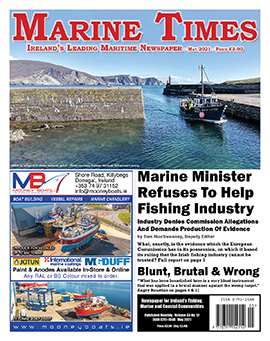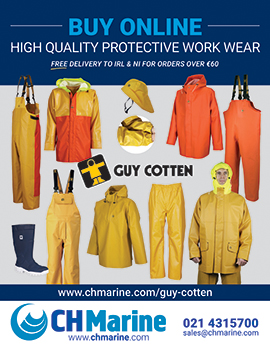Explorers launch Wild About Wildlife on the Seashore Toolkit for Teachers
Can you tell the difference between a gastropod and a bivalve? Do you know how to identify a decapod, amphipod, or an isopod? And, can you tell what fish can walk across seaweed, are slippery as butter, or can hide in the sand?
The Marine Institute Explorers Education Programme are delighted to reveal all in the launch of the Wild about Wildlife on the Seashore teachers toolkit that is packed with over 50 online educational resources including films, species information sheets, and cross curricular worksheets, that aim to help teachers and children learn about our wildlife on the seashore.
.jpg)
Explorers Wild about Wildlife on the Seashore - Noirin Burke and barnacles
Patricia Orme, Joint Acting CEO of the Marine Institute, congratulated the Camden Education Trust and the Explorers team on the development and launch of the Explorers teaching resources. “The Explorers Education Programme is leading the way in supporting teachers to teach children about the ocean in the classroom, and having fit-for-purpose materials that can support the curriculum is a great way to start their journey of learning about the ocean.”
“These resources are an important addition to many of the great assets that the Explorers programme provides. Working with educators and outreach teams around the country helps us further encourage learning about our marine biodiversity, environmental care, as well as marine science and technology. Building these relationships with teachers and providing them with the resources they need, is key to ensuring Ireland is well equipped to have future generations of well informed and enthusiastic marine scientists; as well as a society that cares and values our marine environment,” Mrs Orme added.
The new teaching materials include interactive films of seashore safaris covering shellfish, crustaceans and fish found on the rocky shore; species information sheets filled with photos of Irish seashore animals; as well as presentations, cross curricular worksheets and visual art resources with loads of illustrations of animals that can be used in class.
“We are so excited to be launching these materials for teachers and children, where they can go to one website and find all that they need. The teaching resources have been created with the support from outreach educators and teachers and we are delighted to provide all of the content online, which is free to download at www.explorers.ie,” explained Cushla Dromgool-Regan, Explorers Education Strategic Manager, Camden Education Trust.
“Through the work we do with educators, teachers and children, we are aware that often the barriers to teaching about the marine in the classroom can be due to the lack of accessibility and time to create fit-for-purpose education materials that can be used on the primary school curriculum. It has therefore been our aim to create a series of suitable and inspiring materials that help teachers teach marine themes and cover key subjects such as science, maths, language and the visual arts to name a few,” Ms Dromgool-Regan added.
Ms Dromgool-Regan who directed and produced the interactive films with Matt Kelly Productions further added, “The Explorers Wild about Wildlife films have been developed to bring the seashore into the classroom, and we have been very lucky to have some of the Explorers team from Galway Atlantaquaria take part in sharing their expertise about the animals on the shore in the films.”
Noirín Burke, Padraic Creedon and Anna Quinn show the animals that are likely to be found on the seashore, and explain the amazing facts about how the animals have adapted to deal with the extremes of the seashore. This includes animals of all shapes and sizes coping with crashing waves, changing tides, hot and cold weather; as well as a long list of predators that are on the shore.
“Creating these films was certainly a highlight for us and we are really excited about sharing these resources with teachers and children over the coming months. We also get to tell stories about some of our favourite animals, from the barnacle that lives in one spot on its head and feeds with its ‘feet’ to the dogwhelk that can ‘drill holes’ into other shells to eat its prey – just like soup. We hope by bringing these stories about the seashore to the classroom, it helps children feel like they getting a seashore experience with us during the exploration” said Dr Noirin Burke, Explorers support services manager from Galway Atlantaquaria.
The Explorers team have developed over 30 species information sheets covering fish, crustaceans, shellfish, sponges and sea squirts to name a few, which are loaded with photos, and provide a wealth of scientific information that children can use to learn about living things and one of the harshest places for the animals to survive. The information sheets are divided into the animal groups. Each animal includes a coloured photo; quick facts including the English, Irish and Scientific name, size, colour, and lifespan. The information sheets also highlight: where you will find me; what I look like; how I protect myself; what I eat; what likes to eat me; and how I reproduce.
There are also creative art sheets and worksheets that can be used with the films. They can be used in the classroom to help teachers and children with their scientific discovery and learn more about the animals found on the Irish seashore. Over twenty illustrations of the animals, drawn by Sam Roscoe, capture the characteristics of the animals from the shore. From pictures of the blenny that can walk across seaweed to the anemone, sea snails, starfish and sponges, these outline drawings are also free to download for teachers and children to use for inspiration in their creative activities.
The Explorers Education Programme is managed by the Camden Education Trust and funded by the Marine Institute, and is supported by Galway Atlantaquaria working with outreach teams all around Ireland, as well as providing teachers and student teachers training. By launching these resources, the Explorers Education Programme aims to provide children with an opportunity to start their seashore exploration.
For further information about the Explorers Education Programme see the Explorers contacts page. Teachers, educators and those interested in marine education may also like and follow us on Facebook: @ExplorersMarineEducation and Twitter @explorersedu for great ideas and fun facts about the ocean.
The Explorers Education Programme is funded by the Marine Institute, Ireland's state agency for marine research, technology development and innovation.



.jpg)
 Facebook
Facebook Twitter
Twitter